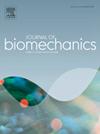Bending moments of PEEK-based root analog implants (RAIs)
IF 2.4
3区 医学
Q3 BIOPHYSICS
引用次数: 0
Abstract
Root-analog implants are frequently fabricated from titanium, which can be associated with various problems, e.g. hypersensitivity to titanium. In this study, we evaluate the bending moments of different polyetheretherketone-based root analog implants as a metal-free alternative. For this, an extracted tooth 31 and 36 was scanned to create an STL data set of each tooth. These were used to fabricate n = 8 polyetheretherketone-based root analog implants per group, with 5 groups being fabricated per tooth type. Two groups were additively manufactured using material extrusion. The other groups were milled from differnet polyetheretherketone grades. After artificial ageing, the samples were statically loaded until fracture in order to determine the bending moment.
Of the root analog implants in the form of a 31, a white, milled polyetheretherketone grade showed the highest bending moment of 2835.3 ± 509.8 Nmm and an unfilled, additively processed polyetheretherketone grade the lowest. Of the RAIs in the form of a 36, an unfilled, milled polyetheretherketone grade showed the highest bending moment with 29342.6 ± 854.7 Nmm and a white, additively processed polyetheretherketone grade showed the lowest bending moment with 19880.5 ± 7188.6 Nmm. Basically, the results between the additively and subtractively processed groups were significantly different.
In terms of mechanical requirements in the oral cavity, one-piece milled polyetheretherketone −based RAIs appear to provide more predictable results than additively manufactured ones.
Taken together, our study suggests that more solidly designed one-piece root analog implants made of milled polyetheretherketone in the form of molars appear to be able to withstand the mechanical requirements of the oral cavity.
求助全文
约1分钟内获得全文
求助全文
来源期刊

Journal of biomechanics
生物-工程:生物医学
CiteScore
5.10
自引率
4.20%
发文量
345
审稿时长
1 months
期刊介绍:
The Journal of Biomechanics publishes reports of original and substantial findings using the principles of mechanics to explore biological problems. Analytical, as well as experimental papers may be submitted, and the journal accepts original articles, surveys and perspective articles (usually by Editorial invitation only), book reviews and letters to the Editor. The criteria for acceptance of manuscripts include excellence, novelty, significance, clarity, conciseness and interest to the readership.
Papers published in the journal may cover a wide range of topics in biomechanics, including, but not limited to:
-Fundamental Topics - Biomechanics of the musculoskeletal, cardiovascular, and respiratory systems, mechanics of hard and soft tissues, biofluid mechanics, mechanics of prostheses and implant-tissue interfaces, mechanics of cells.
-Cardiovascular and Respiratory Biomechanics - Mechanics of blood-flow, air-flow, mechanics of the soft tissues, flow-tissue or flow-prosthesis interactions.
-Cell Biomechanics - Biomechanic analyses of cells, membranes and sub-cellular structures; the relationship of the mechanical environment to cell and tissue response.
-Dental Biomechanics - Design and analysis of dental tissues and prostheses, mechanics of chewing.
-Functional Tissue Engineering - The role of biomechanical factors in engineered tissue replacements and regenerative medicine.
-Injury Biomechanics - Mechanics of impact and trauma, dynamics of man-machine interaction.
-Molecular Biomechanics - Mechanical analyses of biomolecules.
-Orthopedic Biomechanics - Mechanics of fracture and fracture fixation, mechanics of implants and implant fixation, mechanics of bones and joints, wear of natural and artificial joints.
-Rehabilitation Biomechanics - Analyses of gait, mechanics of prosthetics and orthotics.
-Sports Biomechanics - Mechanical analyses of sports performance.
 求助内容:
求助内容: 应助结果提醒方式:
应助结果提醒方式:


